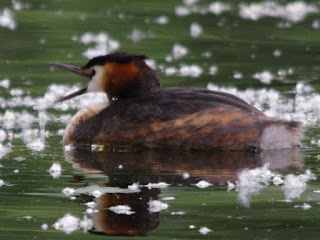The Canada Goose family on the Long Water had returned to the island where their nest was, but then the Mute Swans arrived to reclaim their territory. The result was a tense face-off that lasted for several minutes. There is only one way off the island without an awkward leap, and that way meant barging past the angry swans. So they did, followed by their goslings.
The Moorhens' nest on the reed raft at the east end of the Serpentine has hatched out, and there are three chicks. Here they are being fed next to a tennis ball which an inept dog owner has managed to throw into the enclosure.
On the other side of the raft, a young Lesser Black-Backed Gull had tried to snatch some food a couple of Greylags were eating. They indignantly chased it away.
The Great Crested Grebes' nest on the Serpentine island is still going, but is almost impossible to see behind the baskets of plants.
The Long Water is covered with fluff from the black poplar trees. A grebe seemed bored by this.
The three Coot chicks near the small boathouses are growing up, and have started feeding themselves. They can dive better than their parents, whose abundant feathers make them so buoyant that they have to paddle like fury to stay submerged.
A family of Long-Tailed Tits were looking for insects in a bush near the bridge.
In yesterday's blog, I was wondering about the white Mallard that goes around in a group of three with a drake and a female. Africa Gómez, who runs the excellent blog on bird behaviour The Rattling Crow, identified this bird as a female, because she doesn't have the curly feathers above the tail that are characteristic of a drake. She also said that the duck wasn't constantly assaulted by drakes because they may find her white colour unattractive. There is another Mallard threesome on the Round Pond with two drakes, one of whom is the odd pale one with the brown head. Could the mutation that caused his pale colour also have left him less sexually voracious than a normal male Mallard, so that he is tolerated by the other drake?
Today, for the first time, a Nuthatch came to my hand to be fed. It returned several times and perched for several seconds on my finger looking at me with mild curiosity. I wish I could have photographed it there.









This comment has been removed by the author.
ReplyDeleteThis comment has been removed by the author.
Delete